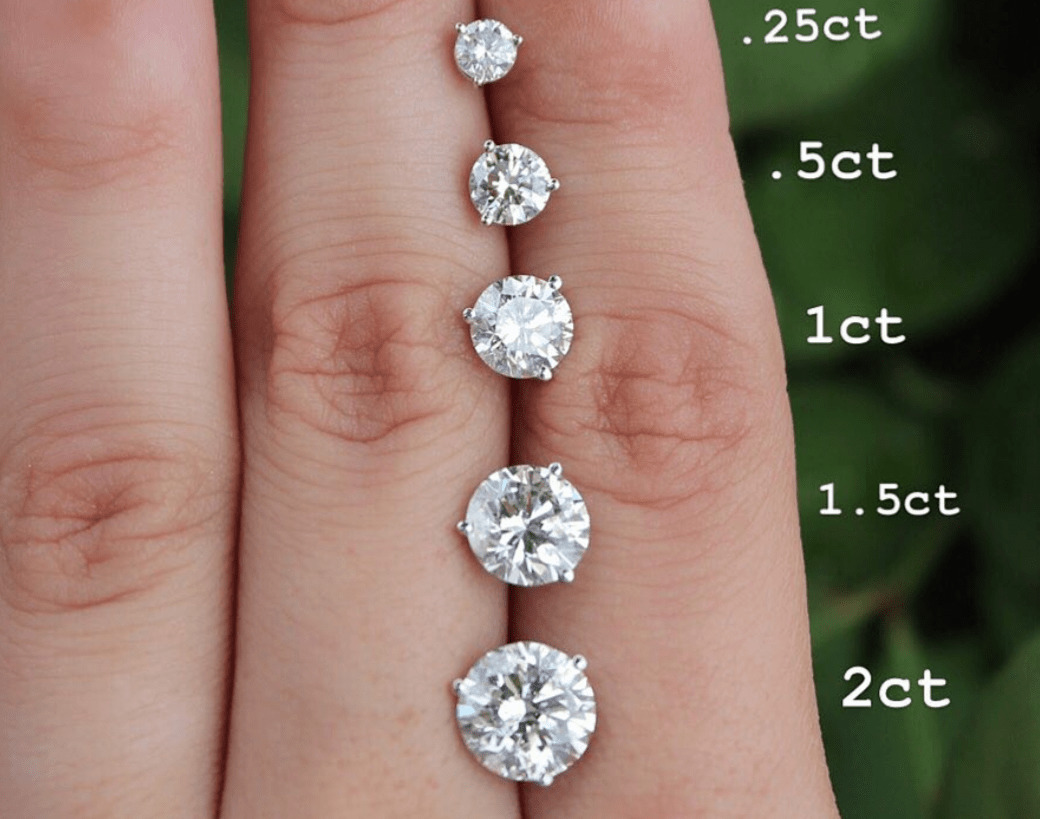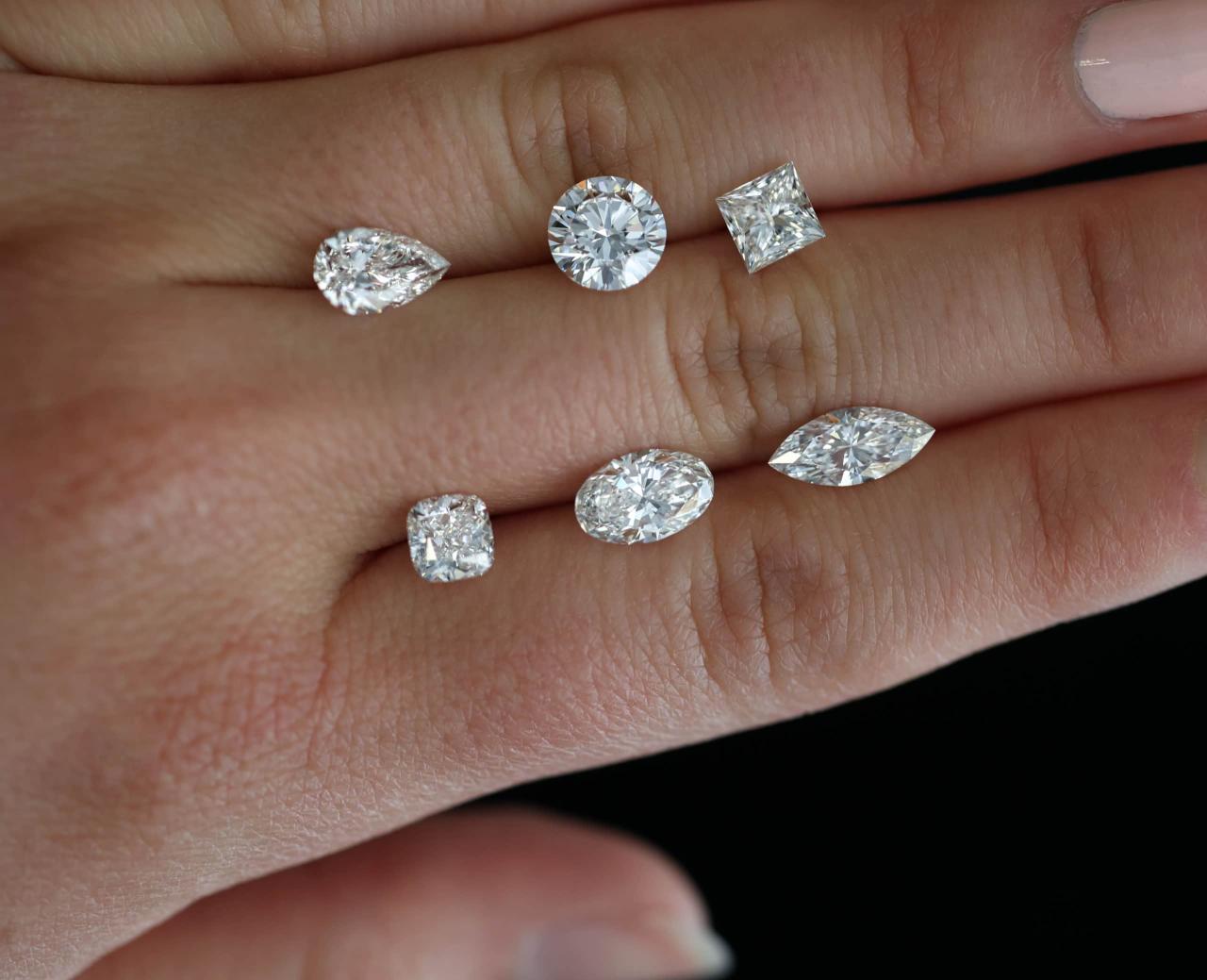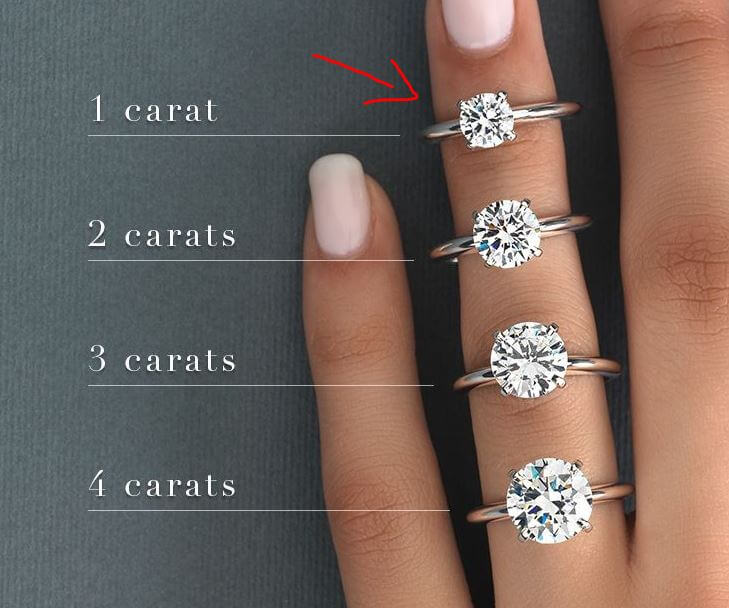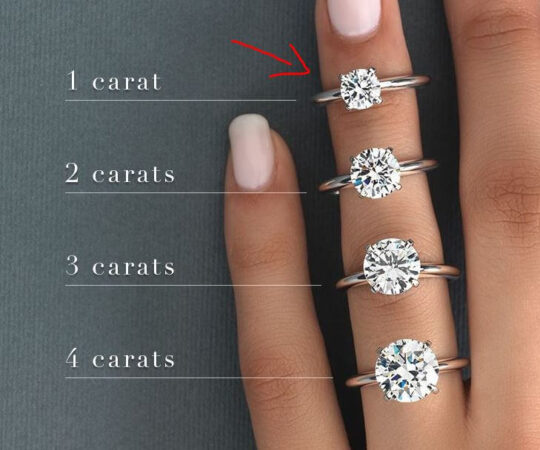
How big is a 1 carat diamond? This question is often asked by those considering purchasing a diamond, especially for engagement rings. While the term “carat” refers to a diamond’s weight, it’s not a direct indicator of its visual size. Factors like cut, shape, and even the diamond’s setting can significantly influence how large a diamond appears.
This article will delve into the intricacies of carat weight, exploring its relationship to diamond size and the other factors that impact a diamond’s visual appearance. We’ll also examine how carat weight affects the price of a diamond and provide examples of real-world jewelry featuring 1-carat diamonds.
Understanding Carat Weight

Carat weight is a crucial factor in determining the value of a diamond. It refers to the diamond’s weight, and it’s a common misconception that a larger carat weight always translates to a more expensive diamond. While a bigger diamond usually commands a higher price, other factors like cut, clarity, and color also play a significant role. Understanding carat weight is essential for making informed decisions when purchasing a diamond.
Carat Weight Measurement
Carat weight is measured using a precise scale, with one carat equaling 200 milligrams (0.2 grams). The weight is typically expressed in decimal form, with a 1.5-carat diamond weighing 300 milligrams. Carat weight is not directly related to the diamond’s size, as different cuts can result in varying appearances for the same carat weight.
Diamond Size and Carat Weight
The size of a diamond is directly proportional to its carat weight. However, the relationship is not linear. A 1-carat diamond will not be twice the size of a 0.5-carat diamond. This is because the volume of a sphere increases exponentially with its radius.
Here are some examples of diamond sizes corresponding to different carat weights:
| Carat Weight | Approximate Diameter |
|---|---|
| 0.25 Carat | 4.5 mm |
| 0.50 Carat | 5.5 mm |
| 1.00 Carat | 6.5 mm |
| 2.00 Carat | 8.5 mm |
It’s important to note that these are just approximate values, and the actual size can vary depending on the diamond’s cut and shape.
Diamond Size and Visual Appearance

While carat weight is a significant factor in determining a diamond’s price, it doesn’t solely dictate its visual size. The interplay of cut, shape, and carat weight creates a complex relationship that influences how a diamond appears to the eye.
The Relationship Between Carat Weight and Diamond Size
Carat weight directly corresponds to a diamond’s mass. A one-carat diamond weighs 200 milligrams. However, the visual size of a diamond is not solely determined by its carat weight. The cut and shape of a diamond play a crucial role in how large it appears. For instance, a well-cut round brilliant diamond can appear larger than a poorly cut diamond of the same carat weight. This is because the cut influences how light interacts with the diamond, impacting its brilliance and overall visual size.
How Cut and Shape Influence Visual Size
The cut of a diamond refers to the angles and proportions of its facets. A well-cut diamond maximizes light reflection and refraction, resulting in greater brilliance and a larger visual appearance. The shape of a diamond also affects its perceived size. For example, a princess-cut diamond with sharp corners can appear smaller than a round brilliant diamond of the same carat weight. This is because the round brilliant shape has a more expansive surface area.
Examples of Diamonds with the Same Carat Weight but Different Visual Sizes
Consider two diamonds, both weighing one carat. One is a round brilliant diamond with an excellent cut, while the other is a princess-cut diamond with a fair cut. The round brilliant diamond, due to its excellent cut, will appear larger and more brilliant than the princess-cut diamond with a fair cut. This is because the round brilliant diamond’s facets are angled to maximize light reflection, creating a larger visual impression. Conversely, the princess-cut diamond’s poor cut will result in less light reflection, making it appear smaller and less brilliant.
Factors Affecting Diamond Price: How Big Is A 1 Carat Diamond
The price of a diamond is determined by a complex interplay of factors, with carat weight being a primary influence. However, other characteristics play equally significant roles in determining the value of a diamond. Understanding these factors is crucial for making informed decisions when purchasing a diamond.
Carat Weight
Carat weight, often referred to as “carat,” is the most prominent factor influencing a diamond’s price. A carat is a unit of weight for gemstones, with one carat equaling 200 milligrams. Diamonds are typically priced per carat, and larger diamonds command higher prices. The price increase with carat weight is not linear. In general, larger diamonds are rarer and therefore more expensive.
A 1-carat diamond can be significantly more expensive than two 0.5-carat diamonds, even though the total carat weight is the same.
This phenomenon is due to the exponential increase in rarity as the carat weight increases.
Cut
Cut refers to the diamond’s proportions, symmetry, and polish, which determine its brilliance, fire, and scintillation. A well-cut diamond reflects light effectively, creating a dazzling sparkle. The American Gem Society (AGS) and the Gemological Institute of America (GIA) use grading systems to assess the quality of a diamond’s cut.
- Excellent Cut: Diamonds with an excellent cut exhibit optimal brilliance and fire, maximizing light reflection and dispersion.
- Very Good Cut: These diamonds display good brilliance and fire, although they may not be as dazzling as diamonds with an excellent cut.
- Good Cut: Good cut diamonds have acceptable brilliance and fire, but they may not be as sparkly as diamonds with higher cut grades.
- Fair Cut: Fair cut diamonds have limited brilliance and fire due to their proportions and symmetry.
- Poor Cut: Poor cut diamonds lack brilliance and fire and may appear dull or lifeless.
A diamond’s cut is a critical factor in determining its price. Diamonds with excellent cuts are generally more expensive than diamonds with lower cut grades, even if they have the same carat weight, clarity, and color.
Clarity, How big is a 1 carat diamond
Clarity refers to the presence or absence of inclusions (internal imperfections) and blemishes (external imperfections) within a diamond. The GIA uses a 10-point clarity scale to grade diamonds based on the size, number, and position of inclusions and blemishes.
- Flawless (FL): Diamonds with no inclusions or blemishes visible under 10x magnification.
- Internally Flawless (IF): Diamonds with no inclusions visible under 10x magnification, but may have minor blemishes on the surface.
- Very Very Slightly Included (VVS1 and VVS2): Diamonds with inclusions that are very difficult to see under 10x magnification.
- Very Slightly Included (VS1 and VS2): Diamonds with inclusions that are slightly easier to see under 10x magnification.
- Slightly Included (SI1 and SI2): Diamonds with inclusions that are visible under 10x magnification.
- Included (I1, I2, and I3): Diamonds with inclusions that are readily visible under 10x magnification.
Diamonds with higher clarity grades (FL to VVS) are rarer and more expensive than diamonds with lower clarity grades (SI to I). The size, nature, and location of inclusions and blemishes can also impact the price.
Color
Color refers to the presence or absence of color in a diamond. The GIA uses a letter grading system to assess the color of diamonds, with “D” representing colorless diamonds and “Z” representing diamonds with a noticeable yellow or brown tint.
- D, E, and F: Colorless diamonds, considered the most desirable and expensive.
- G, H, and I: Near colorless diamonds, with a slight tint that is difficult to detect with the naked eye.
- J, K, and L: Faintly colored diamonds, with a subtle yellow or brown tint that may be noticeable in certain lighting conditions.
- M, N, O, P, Q, R, S, T, U, V, W, X, Y, and Z: Diamonds with a noticeable yellow or brown tint, which can affect their brilliance and fire.
Colorless diamonds are generally more expensive than diamonds with a color tint. However, the price difference between colorless and near colorless diamonds is often minimal, and many people find that diamonds with a slight color tint are still beautiful and affordable.
Price Per Carat
Price per carat refers to the cost of a diamond per unit of weight (carat). This metric is used to compare the value of diamonds with different carat weights.
For example, a 1-carat diamond priced at $10,000 has a price per carat of $10,000, while a 0.5-carat diamond priced at $4,000 has a price per carat of $8,000.
Diamonds with higher price per carat values are generally considered more valuable and desirable. However, it’s important to consider all factors (carat weight, cut, clarity, and color) when comparing the price per carat of different diamonds.
Visual Representation of a 1-Carat Diamond
Understanding the dimensions of a 1-carat diamond can be challenging, as its size depends on its shape. A round brilliant diamond with a 1-carat weight will have a different diameter and depth than a princess cut diamond with the same weight. This section will provide a visual representation of a 1-carat diamond in various shapes, illustrating its dimensions and shape.
Dimensions of a 1-Carat Diamond in Different Shapes
The table below shows the approximate dimensions of a 1-carat diamond in different shapes:
| Shape | Diameter (mm) | Width (mm) | Depth (mm) |
|---|---|---|---|
| Round Brilliant | 6.5 | 6.5 | 4.0 |
| Princess | 5.5 | 5.5 | 3.5 |
| Emerald | 6.0 | 5.5 | 3.5 |
| Oval | 7.0 | 5.5 | 3.5 |
| Pear | 7.0 | 5.0 | 3.5 |
| Marquise | 8.0 | 4.0 | 3.5 |
Visual Representation of a 1-Carat Round Brilliant Diamond
Imagine a circle with a diameter of 6.5 millimeters. This represents the face-up view of a 1-carat round brilliant diamond. The depth of the diamond is approximately 4 millimeters, meaning it extends 4 millimeters from the top surface to the bottom.
Visual Representation of a 1-Carat Princess Cut Diamond
A 1-carat princess cut diamond has a square shape, with sides measuring approximately 5.5 millimeters each. The depth of the diamond is about 3.5 millimeters.
Visual Representation of a 1-Carat Emerald Cut Diamond
An emerald cut diamond is rectangular, with a 1-carat diamond typically measuring around 6 millimeters in length and 5.5 millimeters in width. Its depth is approximately 3.5 millimeters.
Visual Representation of a 1-Carat Oval Diamond
An oval diamond is an elongated version of a round brilliant diamond. A 1-carat oval diamond can have a length of approximately 7 millimeters and a width of around 5.5 millimeters. Its depth is similar to other shapes, around 3.5 millimeters.
Visual Representation of a 1-Carat Pear Shaped Diamond
A pear-shaped diamond is a combination of a round and a marquise shape. A 1-carat pear diamond can have a length of approximately 7 millimeters and a width of 5 millimeters. Its depth is similar to other shapes, around 3.5 millimeters.
Visual Representation of a 1-Carat Marquise Diamond
A marquise diamond has an elongated oval shape with pointed ends. A 1-carat marquise diamond can have a length of approximately 8 millimeters and a width of 4 millimeters. Its depth is similar to other shapes, around 3.5 millimeters.
These dimensions are approximations, and actual measurements can vary slightly depending on the specific diamond’s cut and proportions. However, this table and the visual representations provide a general idea of the size and shape of a 1-carat diamond in different cuts.
Summary

Understanding the relationship between carat weight and diamond size is crucial for making informed decisions when purchasing a diamond. While carat weight is a significant factor, it’s not the only determinant of a diamond’s beauty and value. By considering factors like cut, clarity, color, and even the setting, you can choose a diamond that perfectly suits your needs and budget.
Commonly Asked Questions
What is the difference between a 1-carat diamond and a 2-carat diamond?
A 2-carat diamond is twice as heavy as a 1-carat diamond, but it won’t necessarily appear twice as large. The visual size can vary depending on the diamond’s cut, shape, and setting.
Is a 1-carat diamond too small for an engagement ring?
The size of a diamond in an engagement ring is a matter of personal preference. A 1-carat diamond can be a beautiful and meaningful choice, especially when paired with a stunning setting.
What is the average price of a 1-carat diamond?
The price of a 1-carat diamond can vary widely depending on factors like cut, clarity, color, and origin. It’s best to consult with a reputable jeweler for an accurate price estimate.
Can I find a 1-carat diamond for under $5,000?
It’s possible to find a 1-carat diamond for under $5,000, but it’s important to be realistic about the quality and clarity you can expect at that price point. It’s essential to balance price with desired qualities to find a diamond that fits your budget and preferences.





